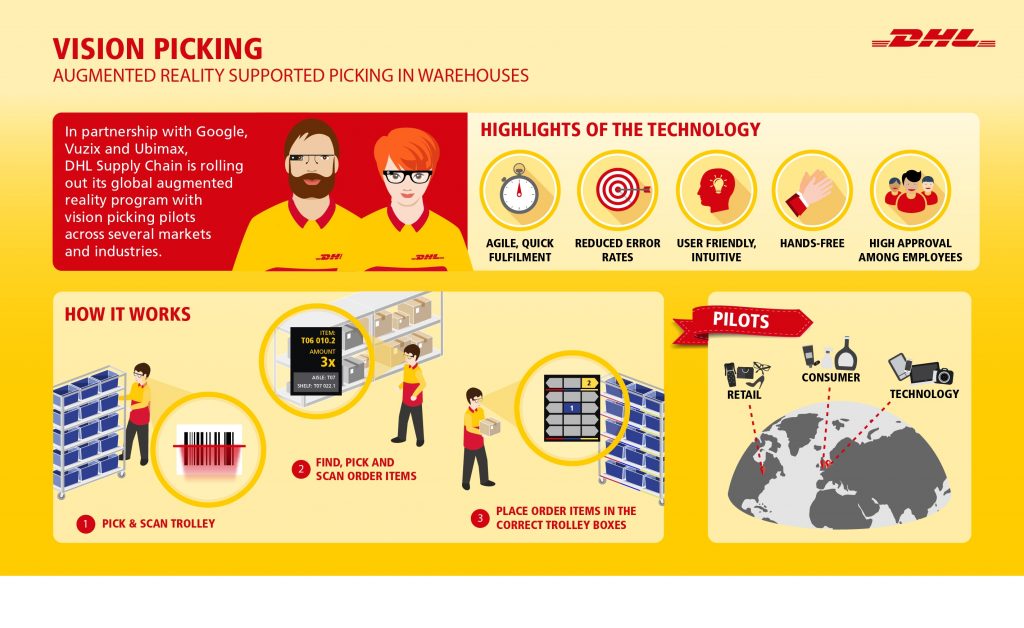During the International Marketing Research course of the International Business bachelor at the Rotterdam School of Management, my team members and I were instructed to research, analyse and evaluate the potential of Google Glass. Through focus groups and questionnaires we learnt that while most respondents found the product intriguing, and would like to try it out, very few of them would actually be willing to purchase it. Around two years later, it has become increasingly clear that the slick virtual reality glasses failed to gain commercial success. Why? Not only because of its price tag – but especially because Google failed to make clear to the customer what problem the product solved, or why they would need to have it. (Altman, 2015)
Although virtual reality glasses have not (yet) become a hit with recreational consumers (other than early adopters), its potential in the logistics sector is being increasingly explored. DHL, one of the world’s leading logistics companies, successfully carried out a pilot project testing smart glasses in 2014 (DHL, 2015). The company is setting an example in how augmented reality could create an industry disruption in the logistics sector, and how it could revolutionise the order processing, transportation, and delivery-services business models that are currently the standard in the industry.
The augmented reality glasses were developed in cooperation with Google, Vuzix and Ubimax, with which DHL will continue to partner to further optimize the glasses. In its Bergen op Zoom warehouse in the Netherlands, where it carries out logistics services for Ricoh (a Japanese electronics company), DHL asked 10 of its warehouse staff to test the smart glasses during the order picking process, for a duration of three weeks. During the pilot, more than 20,000 orders were picked, and over 9,000 orders were fulfilled. The employees were equipped with Google Glass or VuzixM100 glasses containing Ubimax’s special xPick software. The head-mounted devices display all necessary task information, along with aisle location, product location and the required quantity, so that the correct products are placed in the correct trolley boxes. (DHL, 2015)
The result? The project led to a decrease in picking errors and an overall 25% increase in efficiency during the picking process. It also proved popular amongst warehouse staff, who perceived the technology as user-friendly, intuitive and convenient due to its hands-free aspect. (DHL, 2015)
In early September 2016, DHL announced that it will start rolling out more pilot projects in the Netherlands, the US and the UK to further adopt the technology in its warehouses (Retailnews.nl, 2016). It is now also looking at how augmented reality could add value in transportation operations and last-mile delivery processes. M&A advisory firm Digi-Capital estimates that the augmented reality market will grow to $150 billion by 2020 (DHL, 2016).
As DHL further explores the added value of augmented reality in logistics, it is interesting to brainstorm about the economic feasibility of augmented reality glasses in other sectors. Think about the supermarket sector, for example; by equipping smart glasses with real-time stock information, the staff would be able to restock its on-the-floor products more efficiently. They would also be able to more quickly find the products that are overdue and need to be replaced.
Do you see the potential of augmented reality in other B2B or B2C sectors?

Sources:
- Altman, I. (2015). Why Google Glass Failed And Why Apple Watch Could Too. [online] Forbes.com. Available at: http://www.forbes.com/sites/ianaltman/2015/04/28/why-google-glass-failed-and-why-apple-watch-could-too/#7cb6915d58ec [Accessed 15 Sep. 2016].
- DHL, (2015). DHL successfully tests Augmented Reality application in warehouse. [online] Dhl.com. Available at: http://www.dhl.com/en/press/releases/releases_2015/logistics/dhl_successfully_tests_augmented_reality_application_in_warehouse.html [Accessed 15 Sep. 2016].
- DHL, (2016). DHL rolls out global augmented reality program. [online] Dhl.com. Available at: http://www.dhl.com/en/press/releases/releases_2016/all/logistics/dhl_rolls_out_global_augmented_reality_program.html [Accessed 15 Sep. 2016].
- Logistiek Totaal, (2016). DHL investeert in vision picking. [online] Logistiek Totaal. Available at: https://www.logistiektotaal.nl/marktnieuws/dhl-investeert-vision-picking/98923/ [Accessed 15 Sep. 2016].
- Retailnews.nl, (2016). DHL zet in op orderpicken met slimme bril – RetailNews. [online] RetailNews. Available at: http://www.retailnews.nl/nieuws/6jeruIAEROaoWv2sSmeiXw-0/dhl-zet-in-op-orderpicken-met-slimme-bril.html [Accessed 15 Sep. 2016].
- Woods, R. (2015). Can DHL smart glasses augment logistics reality? | Air Cargo World. [online] Aircargoworld.com. Available at: http://aircargoworld.com/can-dhl-smart-glasses-augment-logistics-reality-10245/ [Accessed 15 Sep. 2016].


Dear Madeleine, thank you for your interesting post! I had no idea DHL was doing this, and I think it is great! If the other projects turn out to be successfull too, I think the implementation would be very successful in other warehouses as well. More and more people order online, and warehouses are becoming larger and larger, and e-commerce companies try to reduce their delivery time as well. The glasses, in my opinion, seem to provide a great way to make the picking process faster and more efficient.
When I thought about your question, however, I had a hard time coming up with other sectors that could benefit from this too. Maybe pharmacies, as they often need to give or send medicines to people, and this needs to be done error free and efficient? Or perhaps supermarket delivery services, although both are similar, as you need to pick the product and send it. Or maybe in airports, when suitcases get lost sometimes. Perhaps with this technology, less suitcases would end up being lost or in the wrong plane.
I am very curious to know what will happen with DHL, so I will definitely keep a close eye on the news!